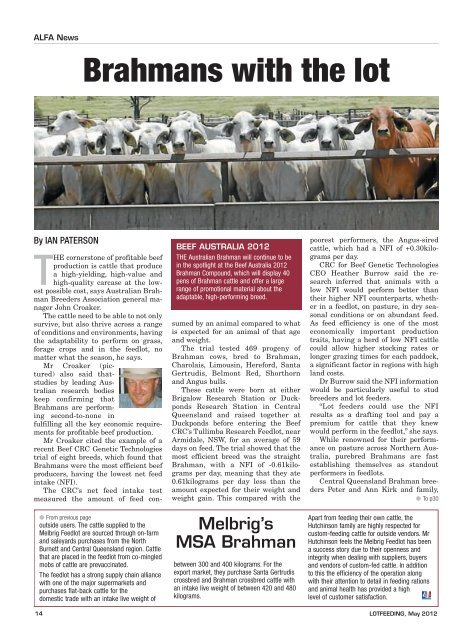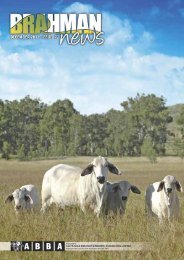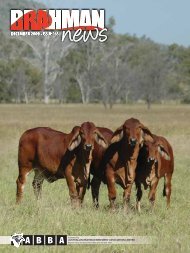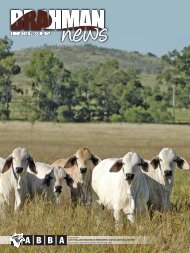Lot Feeding Journal - Australian Brahman Breeders Association
Lot Feeding Journal - Australian Brahman Breeders Association
Lot Feeding Journal - Australian Brahman Breeders Association
Create successful ePaper yourself
Turn your PDF publications into a flip-book with our unique Google optimized e-Paper software.
ALFA News<br />
By IAN PATERSON<br />
<strong>Brahman</strong>s with the lot<br />
THE cornerstone of profitable beef<br />
production is cattle that produce<br />
a high-yielding, high-value and<br />
high-quality carcase at the lowest<br />
possible cost, says <strong>Australian</strong> <strong>Brahman</strong><br />
<strong>Breeders</strong> <strong>Association</strong> general manager<br />
John Croaker.<br />
The cattle need to be able to not only<br />
survive, but also thrive across a range<br />
of conditions and environments, having<br />
the adaptability to perform on grass,<br />
forage crops and in the feedlot, no<br />
matter what the season, he says.<br />
Mr Croaker (pictured)<br />
also said thatstudies<br />
by leading <strong>Australian</strong><br />
research bodies<br />
keep confirming that<br />
<strong>Brahman</strong>s are performing<br />
second-to-none in<br />
fulfilling all the key economic requirements<br />
for profitable beef production.<br />
Mr Croaker cited the example of a<br />
recent Beef CRC Genetic Technologies<br />
trial of eight breeds, which found that<br />
<strong>Brahman</strong>s were the most efficient beef<br />
producers, having the lowest net feed<br />
intake (NFI).<br />
The CRC’s net feed intake test<br />
measured the amount of feed con-<br />
● From previous page<br />
outside users. The cattle supplied to the<br />
Melbrig Feedlot are sourced through on-farm<br />
and saleyards purchases from the North<br />
Burnett and Central Queensland region. Cattle<br />
that are placed in the feedlot from co-mingled<br />
mobs of cattle are prevaccinated.<br />
The feedlot has a strong supply chain alliance<br />
with one of the major supermarkets and<br />
purchases flat-back cattle for the<br />
domestic trade with an intake live weight of<br />
BEEF AUSTRALIA 2012<br />
THE <strong>Australian</strong> <strong>Brahman</strong> will continue to be<br />
in the spotlight at the Beef Australia 2012<br />
<strong>Brahman</strong> Compound, which will display 40<br />
pens of <strong>Brahman</strong> cattle and offer a large<br />
range of promotional material about the<br />
adaptable, high-performing breed.<br />
sumed by an animal compared to what<br />
is expected for an animal of that age<br />
and weight.<br />
The trial tested 469 progeny of<br />
<strong>Brahman</strong> cows, bred to <strong>Brahman</strong>,<br />
Charolais, Limousin, Hereford, Santa<br />
Gertrudis, Belmont Red, Shorthorn<br />
and Angus bulls.<br />
These cattle were born at either<br />
Brigalow Research Station or Duckponds<br />
Research Station in Central<br />
Queensland and raised together at<br />
Duckponds before entering the Beef<br />
CRC’s Tullimba Research Feedlot, near<br />
Armidale, NSW, for an average of 59<br />
days on feed. The trial showed that the<br />
most efficient breed was the straight<br />
<strong>Brahman</strong>, with a NFI of -0.61kilograms<br />
per day, meaning that they ate<br />
0.61kilograms per day less than the<br />
amount expected for their weight and<br />
weight gain. This compared with the<br />
Melbrig’s<br />
MSA <strong>Brahman</strong><br />
between 300 and 400 kilograms. For the<br />
export market, they purchase Santa Gertrudis<br />
crossbred and <strong>Brahman</strong> crossbred cattle with<br />
an intake live weight of between 420 and 480<br />
kilograms.<br />
poorest performers, the Angus-sired<br />
cattle, which had a NFI of +0.30kilograms<br />
per day.<br />
CRC for Beef Genetic Technologies<br />
CEO Heather Burrow said the research<br />
inferred that animals with a<br />
low NFI would perform better than<br />
their higher NFI counterparts, whether<br />
in a feedlot, on pasture, in dry seasonal<br />
conditions or on abundant feed.<br />
As feed efficiency is one of the most<br />
economically important production<br />
traits, having a herd of low NFI cattle<br />
could allow higher stocking rates or<br />
longer grazing times for each paddock,<br />
a significant factor in regions with high<br />
land costs.<br />
Dr Burrow said the NFI information<br />
would be particularly useful to stud<br />
breeders and lot feeders.<br />
“<strong>Lot</strong> feeders could use the NFI<br />
results as a drafting tool and pay a<br />
premium for cattle that they knew<br />
would perform in the feedlot,” she says.<br />
While renowned for their performance<br />
on pasture across Northern Australia,<br />
purebred <strong>Brahman</strong>s are fast<br />
establishing themselves as standout<br />
performers in feedlots.<br />
Central Queensland <strong>Brahman</strong> breeders<br />
Peter and Ann Kirk and family,<br />
● To p30<br />
Apart from feeding their own cattle, the<br />
Hutchinson family are highly respected for<br />
custom-feeding cattle for outside vendors. Mr<br />
Hutchinson feels the Melbrig Feedlot has been<br />
a success story due to their openness and<br />
integrity when dealing with suppliers, buyers<br />
and vendors of custom-fed cattle. In addition<br />
to this the efficiency of the operation along<br />
with their attention to detail in feeding rations<br />
and animal health has provided a high<br />
level of customer satisfaction.<br />
14 LOTFEEDING, May 2012






